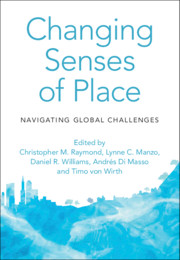Book contents
- Changing Senses of Place
- Changing Senses of Place
- Copyright page
- Dedication
- Contents
- Contributors
- Foreword
- Preface
- Acknowledgements
- Introduction
- Part I Climate Change and Ecological Regime Shifts
- 1 Coral Reef Collapse and Sense of Place in the Great Barrier Reef, Australia
- 2 Navigating the Temporalities of Place in Climate Adaptation
- 3 The Place–Subjectivity Continuum after a Disaster
- 4 Changing Sense of Place and Local Responses to Bengaluru’s Disappearing Lakes
- 5 Place-Making for Regional Conservation
- Part II Migration, Mobility and Belonging
- Part III Renewable Energy Transitions
- Part IV Nationalism and Competing Territorial Claims
- Part V Urban Change
- Part VI Technological and Legal Transformations
- Part VII Design and Planning Strategies for Changing Senses of Place
- Part VIII Conclusion
- Index
- References
4 - Changing Sense of Place and Local Responses to Bengaluru’s Disappearing Lakes
from Part I - Climate Change and Ecological Regime Shifts
Published online by Cambridge University Press: 15 July 2021
- Changing Senses of Place
- Changing Senses of Place
- Copyright page
- Dedication
- Contents
- Contributors
- Foreword
- Preface
- Acknowledgements
- Introduction
- Part I Climate Change and Ecological Regime Shifts
- 1 Coral Reef Collapse and Sense of Place in the Great Barrier Reef, Australia
- 2 Navigating the Temporalities of Place in Climate Adaptation
- 3 The Place–Subjectivity Continuum after a Disaster
- 4 Changing Sense of Place and Local Responses to Bengaluru’s Disappearing Lakes
- 5 Place-Making for Regional Conservation
- Part II Migration, Mobility and Belonging
- Part III Renewable Energy Transitions
- Part IV Nationalism and Competing Territorial Claims
- Part V Urban Change
- Part VI Technological and Legal Transformations
- Part VII Design and Planning Strategies for Changing Senses of Place
- Part VIII Conclusion
- Index
- References
Summary
This chapter elucidates different pathways of how sense of place changes in response to shifts in social-ecological dynamics. In Bengaluru, sense of place in relation to urban lakes is changing and evolving. It is shaped by factors such as urbanisation, climate change and changing demographics, as well as by reinvention of historical uses as they clash with modern activities. Changing sense of place is furthered by the activist work of local lake groups. Through their active work to shape lake meanings, we show how community activists nurture a sense of place that can be collectively harnessed for conservation in the face of ecological deterioration. Importantly, the exchange of memories and place meanings between different stakeholder groups helps facilitate this and also generates new understanding regarding how to manage lakes as sites with multiple social and ecological place meanings.
Keywords
- Type
- Chapter
- Information
- Changing Senses of PlaceNavigating Global Challenges, pp. 53 - 64Publisher: Cambridge University PressPrint publication year: 2021
References
- 1
- Cited by

